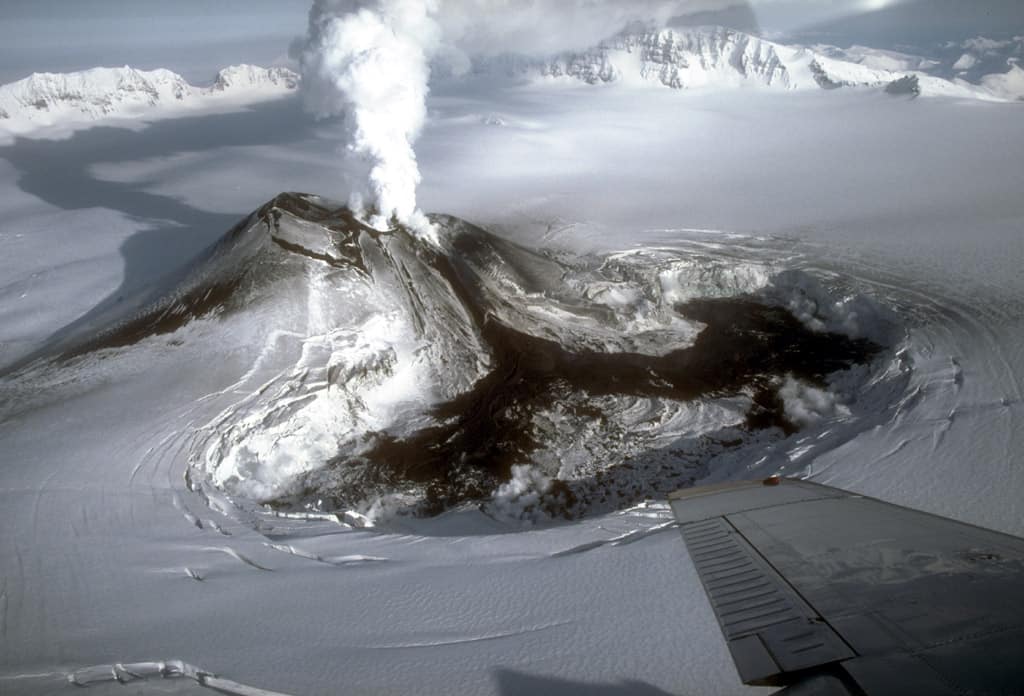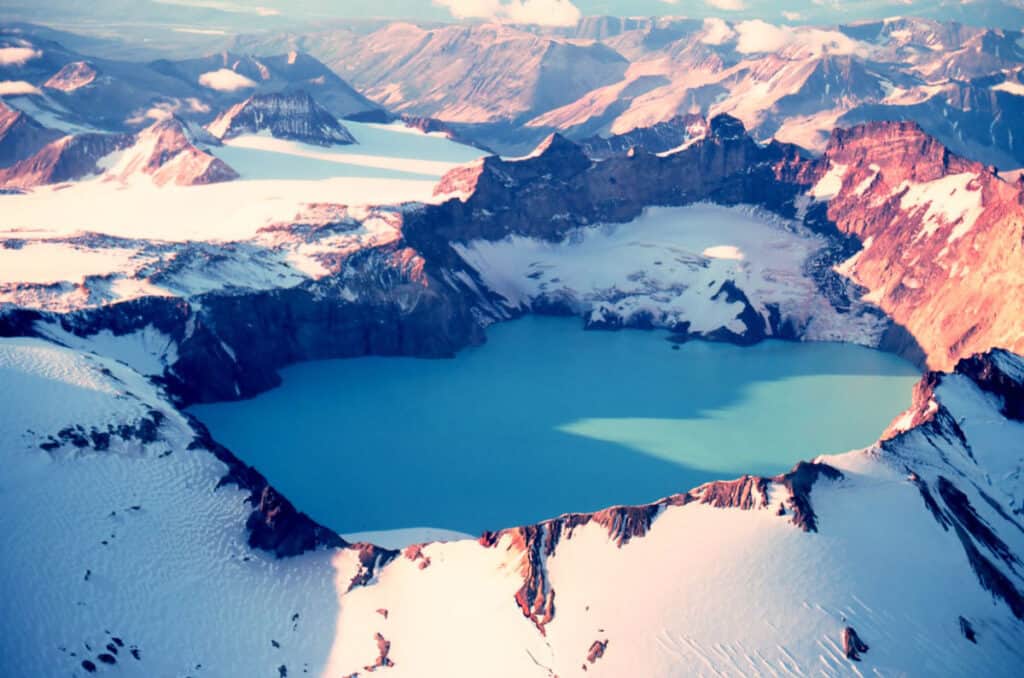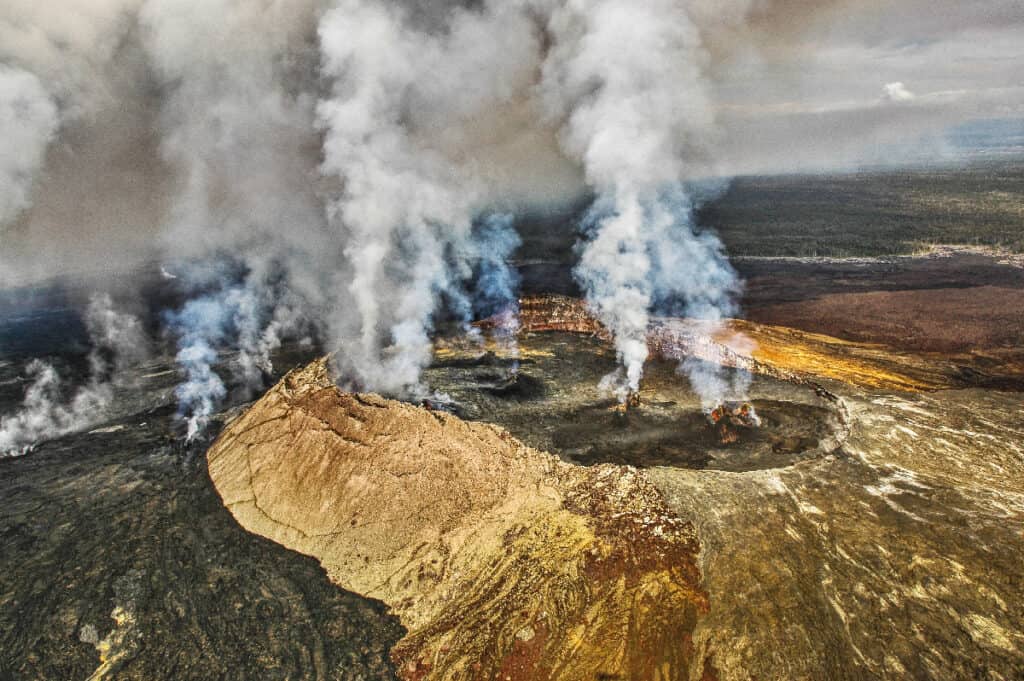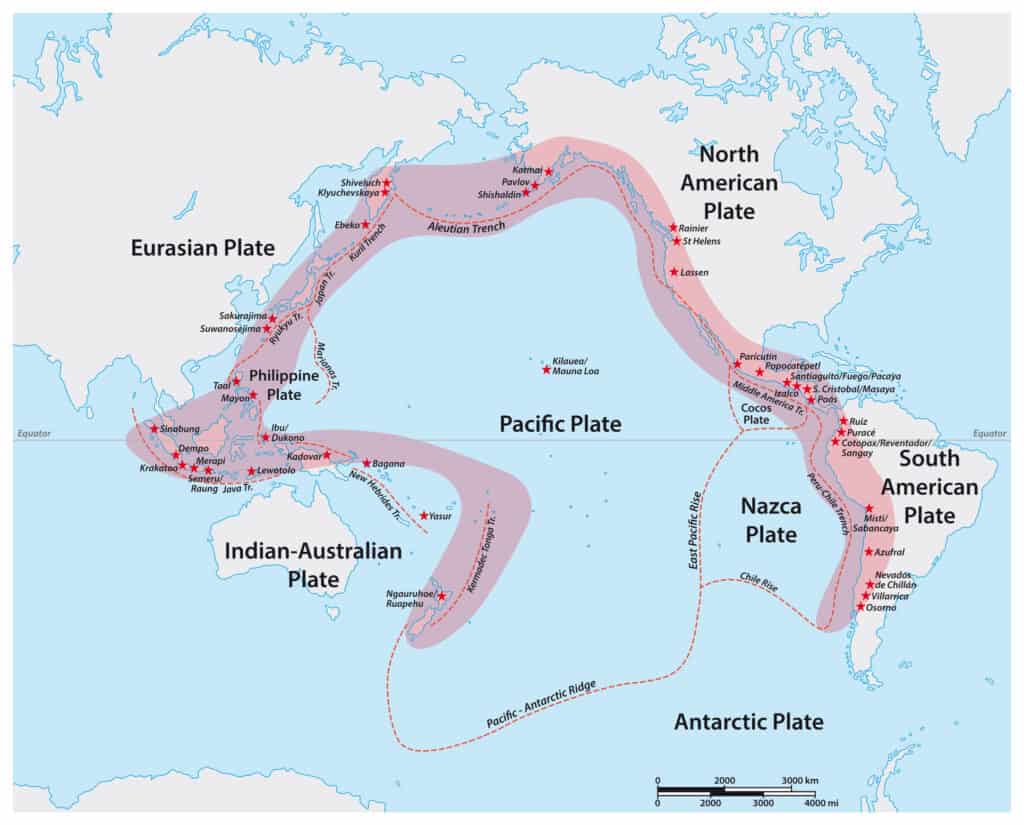Volcanoes are one of those natural wonders that people tend to take for granted. Volcanoes are openings or vents in the Earth’s crust that release lava, tephra, and steam from below the earth’s surface, always one explosion away from changing our landscape entirely once more. The landscape of the United States varies from wide expanses of flat plains to rugged mountain ranges. The volcanic history has helped to shape the land into what we see today. Let’s take a deeper look at volcanoes in the United States.
Volcano Types

Mount Veniaminof is an active stratovolcano in Alaska.
©M.E. Yount, U.S. Geological Survey / This image is in the public domain in the United States because it only contains materials that originally came from the United States Geological Survey, an agency of the United States Department of the Interior. For more information, see the official USGS copyright policy.
What we think of as a classic volcano, a large cone pushing its way out of the earth, isn’t the only way volcanoes exist. There are 5 main types of volcanoes:
- Stratovolcano: A volcano built from layers of its eruptions of lava and ash.
- Cinder Cone: A volcano with a cone built from loose pyroclastic material that comes out during eruptions.
- Shield: The most common type of volcano, where the lava comes forth from the vents and spreads out in a shield shape, building a classic volcano’s base.
- Spatter Cone: Volcanoes that are made up of rocks that erupt, becoming welded together.
- Complex volcanoes: Volcanoes that form irregularly and can have several vents.
A vent is a spot in the earth where magma leaves and becomes lava. Once magma is in the open air, then it is considered lava. Vents can shift over time, and volcanoes can have more than one vent.
Most volcanoes start as shield volcanoes, then vents shift, and material starts to collect around them, and they develop into more complex volcanoes. Pyroclastic material is ash and lava with rock fragments and gasses that come forth out of the volcano and often make it up.
Volcanic eruptions can be devastating to the areas where they occur. Many of the active volcanoes in the U.S. are in Alaska, away from heavily populated areas.
Much of the land as we know it today was formed by volcanic eruptions and other effects that occurred thousands and thousands of years ago.
Find out what lives at the bottom of a volcano.
How Many Volcanoes Are in the United States?

Yes, that’s a lake, in a volcano! Katmai Crater Lake is a pool of water at the top of a giant volcano.
©GCaptain Budd Christman, NOAA Corps / Public Domain – License
The United States is home to a plethora of volcanoes. More than 331 volcanoes are located in the U.S. Many can be found in Alaska and Hawaii, but those are not the only states that can boast a volatile volcanic history.
States that have volcanoes are:
- Alaska
- Arizona
- California
- Colorado
- Hawaii
- Idaho
- Illinois
- Louisiana
- Michigan
- Mississippi
- Missouri
- Nevada
- New Hampshire
- New Jersey
- New Mexico
- Oregon
- South Dakota
- Texas
- Utah
- Virginia
- Washington
- Wyoming.
Almost half the states in the U.S. can boast a volcano or two. 331 of the 1,350 volcanoes found globally are in the United States.
How Many Volcanoes in the United States Are Active?

There are 161 active volcanoes in the United States. Mount Kīlauea on the Island of Hawaii is the most active volcano in the world.
©iStock.com/Vito Palmisano
Of those 331 volcanoes, there are 161 that could be considered active by our standards. An active volcano is a volcano that has had a recent history of eruptions and shows signs of activity currently.
Dormant volcanoes are similar as they have had a recent history of eruptions but no signs currently of being active. Extinct volcanoes haven’t had any eruptions for 6,000 years or more or show no longer signs of activity or connection to magma.
Active volcanoes are monitored for seismic activity. That’s part of what shows us if a volcano is active and may be able to help warn scientists of a potential eruption. The scary thing about volcanoes is that they can erupt without warning.
Luckily, there are only 12 states that have active volcanoes. These are:
- Alaska
- Arizona
- California
- Colorado
- Hawaii
- Idaho
- Oregon
- Nevada
- New Mexico
- Utah
- Washington
- Wyoming.
Both Hawaii and Alaska have had active erupting volcanoes that don’t interfere with day-to-day operations for the states and can even be something fascinating to observe. Tourists in Hawaii love to visit and see the lava flow as it turns into new land.
Aside from the volcanoes in Hawaii and Alaska, there have only been three significant volcanic eruptions in the continental U.S. in the past few hundred years. Activity to mark a volcano as active is different from what we might consider volcanic activity.
The three significant activities listed by the United States Geological Survey have been in:
- California: Lassen Peak in 1917
- Oregon: Mount Hood in the mid-1800s
- Washington: Mount St. Helens in 2008.
These volcanoes do not currently pose a threat to the communities which surround them, but we can’t rule out that they could in the future.
What Is a Supervolcano?

The Yellowstone Caldera is known as a supervolcano.
©Lillac/Shutterstock.com
Supervolcanoes are not just volcanoes that have calderas like many assume. A supervolcano are believed to cause eruptions greater than the average eruption. A supervolcano is thought to do more than just destroy the surrounding areas of a volcano, spreading material even further. It’s believed that the effects could be felt as far as other continents and change everyone’s lives.
A supervolcano is not an official label used by the United States Geological Survey, but they have acknowledged it as a potential possibility. Eruptions by volcanoes can indeed be super powerful and have unforeseen consequences.
A supervolcano eruption could devastate the world. It implies that there would be an eruption over an eight on the Volcano Explosivity Index, which goes as high as an 8. It would be a catastrophic eruption.
This also usually refers to volcanoes that have calderas. A caldera forms when an eruption is strong, and the inside of a cone collapses and makes a shallow bowl over where they vent from.
How Many Supervolcanoes Are in the United States?
Three of the seven supervolcanoes in the world are in the U.S.:
- California: Long Valley Caldera
- New Mexico: Valles Caldera
- Wyoming: Yellowstone.
Long Valley Caldera

Hot springs are present around the Long Valley Caldera.
©Kris Wiktor/Shutterstock.com
Near California’s Mammoth Mountain, the Long Valley Caldera is one of the supervolcanoes listed. An eruption from more than 700,000 years ago is what formed this caldera.
The eruption was so powerful that it caused the volcano’s collapse and pushed out most of the magma there. This area is different from other volcanic areas because this volcano was known to produce two different types of lava in the same place, which is unusual.
Hot springs can be found around the Long Valley Caldera and steam vents, which produce steam either continuously or at various intervals.
This area is popular with tourists and has good hiking opportunities available. The risk of the Long Valley Caldera erupting is low. It is more likely that a different volcano would erupt first in that area.
It is not believed that a nearby eruption could cause the Long Valley Caldera itself to erupt. Thankfully, there is no scientific evidence that localized eruptions can trigger eruptions from other nearby volcanoes.
Valles Caldera
Valles Caldera is a caldera in New Mexico that produces hot springs, steam vents, and natural gas. Indigenous tribes often visited the area to hunt and travel, and there is a lava dome entirely within the caldera.
A lava dome forms when too much lava forcefully erupts and is so thick that it doesn’t travel. Instead, it pools together and hardens into a lava dome, usually around the center of a caldera but doesn’t have to be.
Formed more than a million years ago, this caldera produced multiple strong eruptions that created it and is still active.
The Valles Caldera National Preserve covers most of the Valles Caldera and is a National Park. The caldera rim reaches almost 14 miles and has an intense and rich history of observation and study.
The likelihood of the Valles Caldera erupting is slim. Most of its activity is related to tectonic plates shifting around beneath it.
Yellowstone
Yellowstone is the most well-known of all the supervolcanoes in the United States. This is because it is centered where if it had a supervolcanic eruption, it could affect the entire continent.
This caldera formed over 2.1 million years ago with a powerful eruption. Yellowstone is located over a hot spot, which is a place where magma is close to the surface and often wants to release. Hot spots can move over time and take over different areas.
Since this volcano is located over a hot spot, people believe it is likely to erupt next. Scientists argue with this belief because it doesn’t show any potential signs for a super explosive eruption.
Most of the recent Yellowstone activity only includes light lava flows and some simple expected explosions, nothing of the world-ending variety. There is no proof even that ash spread from an eruption would travel further than the general area, which is one of the fears of an eruption from this supervolcano.
Yellowstone is nothing to worry about, according to scientists at the USGS. There are no signs that anything will occur in the next few years other than the same activity as always.
The volcanoes in the United States are widespread and have done their jobs for millions of years. It’s exciting to realize what is around us that we so often take for granted.
Summary of Volcanoes in the United States
Here’s a recap of information about volcanoes in the U.S.:
| Details | Answer |
|---|---|
| Number of volcano types in the U.S.: | 5 |
| Number of volcanoes in the U.S.: | Over 331 |
| Number of active volcanoes in the U.S.: | 161 |
| Number of states that have active volcanoes: | 12 |
| Number of supervolcanoes in the U.S.: | 3 |
Where are Most Volcanoes Located on Earth?

The western coast of the United States is within The Ring of Fire.
©iStock.com/Rainer Lesniewski
The United States has its share of volcanoes and is actually within what is known as “The Ring of Fire” when it comes to volcanic and seismic activity. This area depicted on the map contains all but ten percent of the world’s earthquakes, and three-quarters of all of the volcanoes on the planet can be found along this amazing ring.
Furthermore, “The Ring of Fire” descends below what is indicated on the map and travels southernly through the continent of Antarctica, where the most southern volcano can be found. It is named Mount Erebus, after the Greek god who symbolizes darkness.
Besides what we see on land, the path of the Ring follows underwater trenches which also are known for their seismic and volcanic activity.
The photo featured at the top of this post is © Dene' Miles/Shutterstock.com
Thank you for reading! Have some feedback for us? Contact the AZ Animals editorial team.






